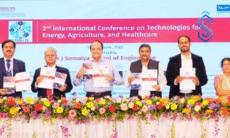New Delhi: The Ministry of Education has published the Unified District Information System for Education Plus (UDISE+) 2024-25 report, presenting a comprehensive analysis of India’s school education system.
The findings highlight unprecedented progress in teaching workforce expansion, student retention, enrolment growth, and infrastructure development across the country.
UDISE+ 2024-25 Marks Over 1 Crore Teachers in India
For the first time since the inception of UDISE+, the total number of teachers in India has crossed the 1 crore mark in the academic year 2024–25.
Also Read: National Awards to Teachers 2025: Department of Higher Education Announces 21 Educators Selected
The teacher workforce rose by 6.7% compared to 2022–23, reaching 1,01,22,420 teachers. This milestone is seen as a significant step toward improving student-teacher ratios and ensuring equitable access to quality education across regions.
Improved Pupil-Teacher Ratio and Student Retention
The report highlights a marked improvement in the Pupil-Teacher Ratio (PTR) across all levels of schooling. PTR now stands at 10 at the foundational level, 13 at preparatory, 17 at middle, and 21 at secondary—well below the National Education Policy’s (NEP) recommended ratio of 1:30.
Retention rates also showed positive trends:
- Foundational: 98.9%
- Preparatory: 92.4%
- Middle: 82.8%
- Secondary: 47.2%
The rise in secondary retention is linked to the growing number of schools offering secondary education.
Dropout Rates Decline Significantly
UDISE+ 2024-25 recorded substantial reductions in dropout rates. At the Preparatory level, dropout rates fell to 2.3%, at the Middle level to 3.5%, and at the Secondary level to 8.2%. These consistent declines reflect effective government initiatives to keep students engaged in education.
Higher Enrolment and Transition Rates
The Gross Enrolment Ratio (GER) improved at both middle (90.3%) and secondary (68.5%) levels in 2024–25. Transition rates also rose, with 98.6% of students moving from foundational to preparatory, 92.2% from preparatory to middle, and 86.6% from middle to secondary.
Also Read: Gender Budgets, Startups, and MSMEs Fuel Women Empowerment in India’s Growth Story
Decline in Single-Teacher and Zero-Enrolment Schools
The number of single-teacher schools fell by 6% and zero-enrolment schools declined sharply by 38% compared to the previous year. This is attributed to targeted interventions and better teacher deployment strategies.
Stronger Digital and Physical Infrastructure
The report shows significant infrastructure progress:
- Computer access: 64.7% of schools (up from 57.2%).
- Internet access: 63.5% of schools (up from 53.9%).
- Electricity coverage: 93.6%.
- Drinking water: 99.3%.
- Girls’ toilets: 97.3%, Boys’ toilets: 96.2%.
- Handwashing facilities: 95.9%.
- Additionally, 54.9% of schools are now equipped with ramps and handrails, improving accessibility for students with disabilities.
Growth in Female Representation
The share of female teachers rose to 54.2% in 2024-25, reflecting stronger gender balance in the education workforce. Girls’ enrolment also inched upward to 48.3%, showing progress toward gender equity in education.
A Landmark Year for Indian Education
The UDISE+ 2024-25 findings collectively showcase how India’s education sector is evolving through increased teacher strength, improved infrastructure, reduced dropouts, and higher participation from girls. These achievements mark a significant stride in the nation’s journey toward inclusive, equitable, and quality education.










